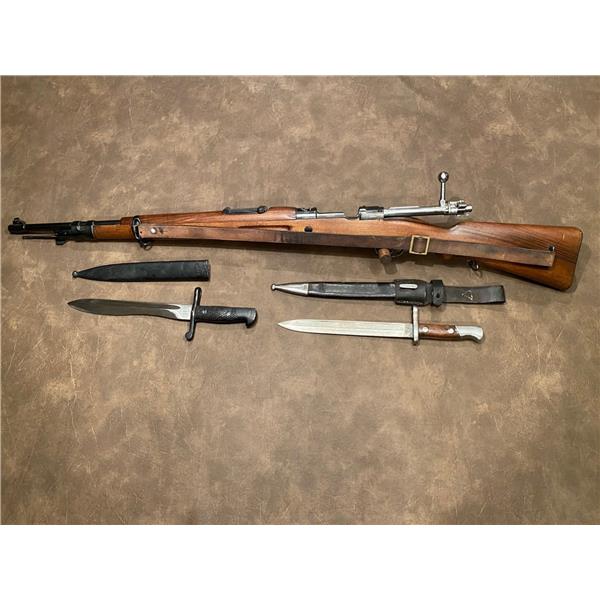
At the same time, Mauser developed the 7×57mm Mauser cartridge for the Spanish Army, which adopted the round the following year for the M1892 rifles. Between 5,000 and 8,000 of the rifles were built for Spain. Mauser's design work produced the Model 1892, a transitional design that was manufactured in limited numbers for the Spanish Army. As a result, Paul Mauser decided to design a new rifle that would correct the problems with the earlier rifles, and allow the company to secure more arms contracts. The stripper clip guide and the clips themselves were also unreliable and the bolt design allowed the rifle to double-feed rounds of ammunition. Among the issues that had been identified were an unreliable extractor, a detachable box magazine that was frequently lost and extended below the bottom of the stock, which caused problems with carrying the rifle slung.
1916 SPANISH MAUSER BAYONET SERIES
Trials with these guns provided a series of improvement suggestions for Mauser in addition to Spanish experiences, by that time, the 1889, 1890, and 1891 series of Mauser rifles had been in service with various armies long enough to highlight deficiencies in the designs. The impetus for the change was a series of defeats of Spanish forces around the enclave at Melilla in North Africa. These rifles did not satisfy the Spanish Army, and so on 2 December 1891, the Army ordered 1,200 Model 1891 Mausers that used new smokeless powder ammunition.

In 1887, the Spanish Army began trials of the Turkish Model 1887 Mauser rifles, which utilized black powder cartridges. The marked superiority of the M1893 over its American opponent in the Spanish–American War, the Krag–Jørgensens, led the US Army to develop the M1903 Springfield, which itself heavily copied Mauser's designs. For his work, Mauser received the Grand Cross of the Order of Military Merit from Spain. The M1893 proved to be a major success for Mauser, as it provided the basis for later developments, including the Models 18-commonly referred to as Swedish Mausers-the Model 1895, and ultimately the Gewehr 98, one of the most successful bolt-action rifle designs ever produced. In Ottoman service, M1893 rifles saw limited action during the Greco-Turkish War of 1897, the Balkan Wars of 1912–1913, and World War I in 1914–1918. The converted rifles were used for training and for the Guardia Civil through the 1950s. The M1916 short rifles remained in production in Spain until 1951, and many of these later rifles were converted to shoot either 7.92×57mm Mauser or 7.62×51mm NATO, including some that were extensively modified as the FR7.

All versions of the rifle saw extensive service in the Spanish Army, beginning in the Spanish–American War in 1898, the Rif War of 1920–1927, and the Spanish Civil War of 1936–1939. The M1893 was developed into several variants, including a shortened carbine adopted by the Spanish as the M1895, and as the M1913 and M1916 short rifles. The M1893 introduced a short staggered-column box magazine that fit flush with the bottom of the stock the magazine held five smokeless 7×57mm Mauser rounds, which could be reloaded quickly by pushing a stripper clip from the top of the open bolt. The M1893 was based on the experimental M1892 rifle, which Paul Mauser developed for the Spanish Army as part of a program to correct deficiencies in the earlier 1889, 1890, and 1891 series of Mauser rifles. The Mauser Model 1893 is a bolt-action rifle commonly referred to as the Spanish Mauser, though the model was adopted by other countries in other calibers, most notably the Ottoman Empire. This lot will be professionally packaged and sent by registered mail.Illustration of a Mauser Model 1893 rifle The black leather sheath and its metal parts: mount for the belt (the frog) and the drag are in good condition there lacks only a screw (above the frog), it should not be too hard to replace it. The wood of the handle shows user tracks, all the metal, the mounting nails, pushbutton on the pommel (back of the handle) function just fine and are in good condition.
1916 SPANISH MAUSER BAYONET SERIAL NUMBER
(+ image of two crossed cannons) NACIONAL, TOLEDO '' on the other side marked with serial number 25918 C.Ĭondition The bayonet is in good condition, has some traces, these are age and use related, see pictures. The journal of the bayonet is 40 cm long and marked with the text '' ARTILLERIA F.C.A.

This long model (complete length 55.5 cm) bayonet was used extensively in the Spanish civil war and fits on both models Mauser rifles, both model 1893 and model 1916.

Original Spanish model 1913-1916 Mauser carbine rifle bayonet with original sheath.


 0 kommentar(er)
0 kommentar(er)
